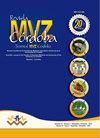古巴两个省屠宰的牛肝片吸虫的经济损失和流行率
IF 0.3
4区 农林科学
Q4 AGRICULTURE, DAIRY & ANIMAL SCIENCE
引用次数: 5
摘要
目标。确定古巴卡马圭省和奥尔金省受感染肝脏和屠宰牛体内存在肝片吸虫所造成的经济损失。材料与方法。本研究基于2012年1月至2018年12月期间在Felipe Fuentes和Cesar Escalante屠宰场进行的解剖病理检查结果。根据整个期间屠宰和受影响动物的数量估计,损失总额为80 312美元(奥尔金)和327 152美元(卡马圭)。对受肝裂裂菌影响的动物进行了比例比较分析,而对肝脏谴责造成的经济损失进行了卡方分析,以确定比例之间存在显著差异。平均数分析(ANOM)确定了共同海损内显著不同的比例。结果。除7月份外,不同屠宰场的动物在11个月内观察到显著差异(p<0.001)。同时,在评估期的所有月份中,受影响肝脏谴责的总损失存在显著差异(p<0.001)。结论。在卡马圭省观察到,受肝原胞菌影响的肝脏受损造成的经济损失和流行率最高,这可能与不同的气候条件有关。因此,建议对两省吸虫媒介寄主动态和幼虫期进行评价。本文章由计算机程序翻译,如有差异,请以英文原文为准。
Pérdidas económicas y prevalencia de Fasciola hepaticaen bovinos sacrificados en dos provincias cubanas
Objective. To determine the economic losses resulting from condemnation of affected livers and the presence of Fasciola hepatica in slaughtered cattle in the provinces of Camaguey and Holguin, Cuba. Materials and Methods. This study was based on the results from an anatomo-pathological examination performed at Felipe Fuentes and Cesar Escalante slaughterhouses between January 2012 and December 2018. The losses, which totaled $ 80 312 USD (Holguin) and $ 327 152 USD (Camaguey), were estimated from the number of slaughtered and affected animals throughout the period. Analyses for the comparisons of proportions were made to animals affected by F.hepatica, whereas the economic losses due to liver condemnation were analyzed by Chi-square to determine the existence of significant differences among the proportions. Analysis of means (ANOM) was made to determine the significantly different proportions within the general average. Results. Significant differences (p<0.001) were observed in animals from different slaughterhouses in 11 months, excluding July. Meanwhile, the total losses due to condemnation of affected livers underwent significant differences (p<0.001) in all the months of the evaluation period. Conclusions. The highest values of economic losses and prevalence due to condemnation of livers affected by F.hepatica were observed in the province of Camaguey, which may have been linked to varying climatic conditions. Hence, evaluation of intermediary host dynamics and the larval stages of the trematode in the two provinces studied were recommended.
求助全文
通过发布文献求助,成功后即可免费获取论文全文。
去求助
来源期刊

Revista Mvz Cordoba
农林科学-奶制品与动物科学
CiteScore
0.70
自引率
0.00%
发文量
41
审稿时长
6-12 weeks
期刊介绍:
The Journal MVZ Córdoba is an open access international scientific journal financed and edited by the University of Córdoba (Colombia). The journal publishes quarterly, continuously in PDF, XML, Epub, original articles, literature reviews, brief communications and clinical cases, peer-reviewed (double-blind) in Spanish and English, which are related to the agricultural and veterinary sciences. The journal is directed to natural and legal persons of veterinary medicine, animal husbandry, public health, epidemiology, aquaculture, biology, basic biomedical sciences and biotechnology and constitutes a space for academic and scientific discussion around the work of professionals in Veterinary Medicine and Zootechnics. Four-monthly publication.
"The Journal MVZ Córdoba supports the policies for registration of clinical trials of the World Health Organization (WHO) and the International Committee of Medical Journal Editors (ICMJE), since it recognizes the importance of these initiatives for international registration and dissemination. of information about clinical studies, in open access. As a result, since 2007, the journal MVZ Córdoba only publishes clinical research articles that have received an identification number in one of the Clinical Trial Registries validated by the criteria established by WHO and ICMJE, whose addresses are available in the ICMJE website. The identification number is recorded at the end of the summary. "
 求助内容:
求助内容: 应助结果提醒方式:
应助结果提醒方式:


